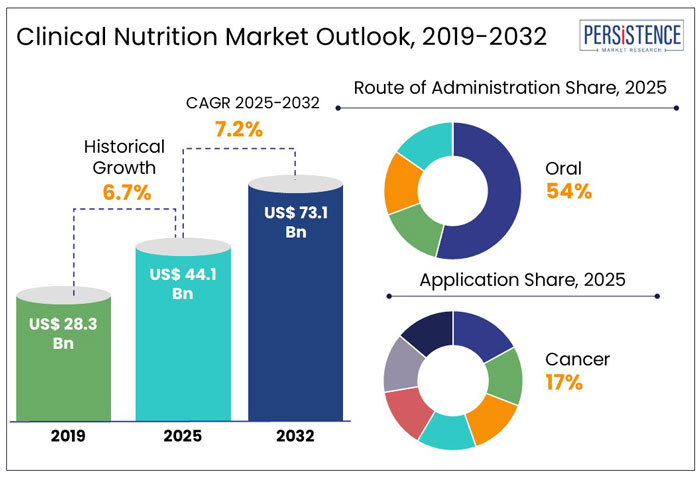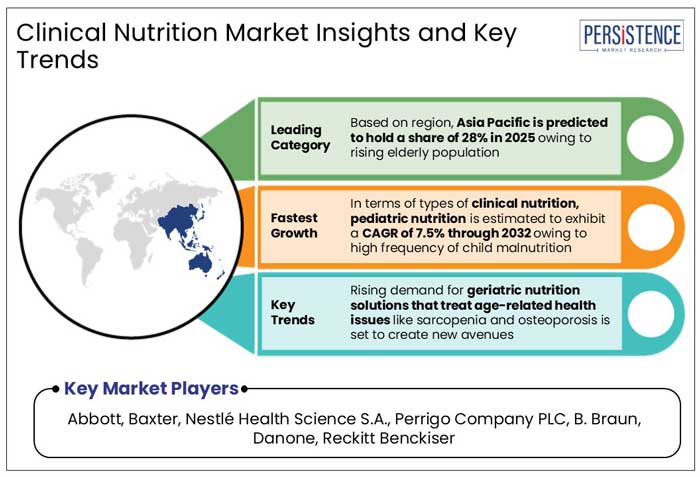Industry: Food and Beverages
Published Date: February-2025
Format: PPT*, PDF, EXCEL
Delivery Timelines: Contact Sales
Number of Pages: 181
Report ID: PMRREP2812
The global clinical nutrition market is estimated to reach a size of US$ 44.1 Bn in 2025. It is predicted to exhibit a CAGR of 7.2% through the assessment period to attain a value of US$ 73.1 Bn by 2032.
Increasing emphasis on tailored dietary solutions based on individual health needs and genetic profiles are propelling growth. Rapid growth of nutritional genomics is predicted to bolster product development.
Integration of digital health technologies, including mobile health apps and telemedicine, are facilitating personalized dietary recommendations. The industry is turning to AI and data analytics for enhanced patient outcomes.

Key Highlights of the Market
|
Global Market Attributes |
Key Insights |
|
Clinical Nutrition Market Size (2025E) |
US$ 44.1 Bn |
|
Market Value Forecast (2032F) |
US$ 73.1 Bn |
|
Projected Growth (CAGR 2025 to 2032) |
7.2% |
|
Historical Market Growth (CAGR 2019 to 2024) |
6.7% |
Enteral and Parenteral Nutrition Saw High Demand Amid COVID-19 from Patients in ICU
The global clinical nutrition market growth was steady at a CAGR of 6.7% in the historical period. The COVID-19 pandemic increased the demand for enteral and parenteral nutrition in intensive care units. Use of nutritional products and oral supplements at home was fueled by increased consumer attention to immunity and preventative health during the same period.
Developments in tailored nutrition along with an increasing prevalence of chronic diseases fostered growth. While plant-based nutrition and allergen-free products satisfy changing consumer tastes, innovations like customized nutritional solutions based on genetics, metabolism, and lifestyle characteristics are poised to completely transform the market.
Emergence of Plant-based Products with Surging Veganism to Push Growth through 2032
The industry is predicted to witness a CAGR of 7.2% through the forecast period. Popularity of plant-based diets and veganism is set to increase the demand for plant-based therapeutic nutrition products. This indicates a shift in consumer preferences toward sustainable and ethical dietary options.
Several people prefer plant-based foods for their health benefits. In response, producers are creating plant-based formulae, like protein supplements derived from pea, soy, or almonds, as well as allergen-free options. For instance,
The oral nutritional supplement is nutritionally balanced, containing a blend of high-quality plant protein derived from pea and soy sources. It is appropriate for vegan, vegetarian, or flexitarian diets, as well as people with cow's milk protein allergies.
Growth Drivers
Rising Cases of Anemia to Augment the Need for Fortified Nutritional Products
Increasing awareness among consumers and healthcare providers regarding certain nutritional deficiencies is propelling growth. For instance, vitamin D supplementation is widely recommended by healthcare experts, especially for older adults, pregnant women, and people who have had limited sun exposure. This has further increased demand for fortified nutritional products and supplements designed specifically for these groups.
China has the world's largest iron deficiency anemia population, with an estimated prevalence of 15%. This approval is predicted to improve the country’s healthcare system in a variety of ways, including the implementation of effective Patient Blood Management (PBM).
Clinical Nutrition Products May Cause Adverse Effects or Complications in Patients, Limiting Use
Adverse effects and difficulties associated with clinical nutrition products market pose a significant barrier to their widespread use. While these products are meant to address specific dietary requirements, incorrect formulation or delivery might result in unexpected consequences, especially in vulnerable populations like juvenile, geriatric, or critically sick patients. Allergic responses are also a problem, especially for items containing allergens like soy, lactose, gluten, or casein.
The potential of nutrient imbalances is another significant restraint, which can occur when vitamins, minerals, or electrolytes are overs supplemented. For example, a disproportionate amount of protein in people with impaired kidney function can deteriorate kidney function, and an excessive amount of iron might be hazardous. Such issues need careful product design and thorough monitoring by healthcare providers, which may limit the use of clinical nutrition products market in homecare settings or areas with inadequate medical oversight, impeding market expansion.
Metabolic Factors to Influence Customized Nutrition Strategies for Disease Management
Innovations in nutrigenomics, which analyze the interaction between genes and nutrition, have resulted in the creation of customized dietary therapies tailored to individual needs. Metabolic variables like insulin resistance or lipid metabolism disorders can alter dietary requirements. Personalized nutrition regimens can help in managing diabetes and cardiovascular disease by optimizing dietary intake.
Lifestyle factors like physical activity, stress, sleep, and dietary preferences influence individual nutritional requirements. As consumers become health-conscious and seek individualized approaches to their well-being, the market for genetic, metabolic, and lifestyle-based nutrition solutions is estimated to witness rapid growth. This surge is predicted to create considerable growth opportunities for clinical nutrition providers. For example,
Types of Clinical Nutrition Insights
Surging Cases of Children Malnutrition is Raising Demand for Pediatric Nutrition
Pediatric nutrition is predicted to exhibit a CAGR of 7.5% through 2032. High frequency of malnutrition, early deliveries, and increased awareness of child health are key factors driving growth.
Emerging economies, where malnutrition rates remain high, witness a considerable demand for pediatric nutrition products, which are frequently backed by government initiatives and non-governmental organizations (NGOs). Infant formulas are showcasing high demand as these supply vital nutrients for optimum growth and development in children who cannot entirely breastfeed.
Developments in specialized pediatric formulation cater to children with specific medical ailments, like metabolic abnormalities, allergies, or gastrointestinal problems. These specialized products promote appropriate nutrition and recovery rates. Rising parental knowledge of the significance of balanced nutrition, particularly in the first 1,000 days of life, is driving demand.
Route of Administration Insights
Enteral Route of Administration is Effective in Delivering Essential Nutrients Directly to Gastrointestinal Tract
Enteral mode of administration is predicted to dominate with a CAGR of 7.7% through 2032. Its ability to provide critical nutrients directly to the GI tract fosters adoption. This approach is commonly used for patients who are unable to eat orally but have a functional digestive system.
Enteral nutrition is less intrusive than parenteral procedures and has a lower risk of problems like infections or metabolic imbalances. It is hence a preferred option in hospitals and homecare settings. Availability of various enteral feeding formulae customized to specific illnesses, like diabetes, cancer, or gastrointestinal issues, accelerates their use.
Novel delivery methods like feeding pumps and portable devices improve patients' convenience and safety in clinical and homecare settings. For instance,

Aging Population in North America to Spur Need for Osteoporosis and Sarcopenia Supplements
North America clinical nutrition market is predicted to hold a share of 32% in 2025. The region’s well-developed healthcare infrastructure, increasing knowledge of clinical nutrition, and rising prevalence of chronic diseases bolster growth.
The aging population in North America is a key driver as the elderly population requires specialized nutritional supplements to treat illnesses like osteoporosis, sarcopenia, and cognitive loss. Clinical nutrition is essential to disease care, especially for patients receiving chemotherapy, managing diabetes, or recovering from surgery. For instance,
Oral mucositis is one of the most common, painful, and debilitating side effects of cancer treatment. Gelclair is a mechanical gel that adheres to the mucosal surface of the mouth and is used to manage and relieve pain. It covers and protects the oral mucosa, thereby promoting healing.
Rising Diabetes Cases in Asia Pacific with 140 Million Predicted by 2045 Spurring Demand for Medical Nutrition
Clinical nutrition market in Asia Pacific is anticipated to hold a share of 28% in 2025. Rising disposable income is driving demand for healthcare and nutrition products. Increasing lifestyle-related diseases like diabetes, obesity, and cardiovascular condition are prompting higher demand for clinical nutrition.
The region is witnessing a demographic shift with a growing elderly population. For instance,
Extensive Hospital Networks in Europe to Enhance Accessibility to Clinical Nutrition Products
Europe clinical nutrition market is predicted to hold a share of 26% in 2025. The region boasts a well-established healthcare system with high standards of medical care. It has an extensive network of hospitals and healthcare providers who facilitate the delivery of clinical nutrition products. For example,
Europe has one of the oldest populations, with projections indicating that by 2040, over 30% of the population in a few countries will be aged 65 or older. This demographic shift increases the need for specialized nutritional support for age-related health issues.
Companies in the clinical nutrition market are highly competitive, with prominent competitors based in areas with strong healthcare systems and cutting-edge research capacities. Businesses from North America and Europe are predicted to dominate the market owing to their established distribution networks, varied product portfolios, and strong emphasis on innovation. These players leverage cutting-edge technologies to create specific nutrition solutions for chronic conditions, pediatric care, and geriatric needs.
As companies extend their online presence, clinical nutrition products are becoming widely available. The emergence of e-commerce has raised direct-to-consumer sales in the industry. Packaging innovations like portable feeding systems and ready-to-consume formats are another significant competitive tactic. The market is becoming more consolidated as partnerships, mergers, and acquisitions allow businesses to broaden their geographic reach and diversify their holdings.
Recent Industry Developments
|
Report Attributes |
Details |
|
Historical Data/Actuals |
2019 – 2024 |
|
Forecast Period |
2025 - 2032 |
|
Market Analysis Units |
Value: US$ Bn/Mn, Volume: As applicable |
|
Geographical Coverage |
|
|
Segmental Coverage |
|
|
Competitive Analysis |
|
|
Report Highlights |
|
|
Customization and Pricing |
Available upon request |
By Types of Clinical Nutrition
By Route of Administration
By Form
By Application
By Region
To know more about delivery timeline for this report Contact Sales

The clinical nutrition industry is predicted to be valued at US$ 44.1 Bn in 2025.
Liquid-form nutrition is in high demand.
In North America, the industry is set to witness significant CAGR of 7.9% through 2032.
Pediatric nutrition is witnessing rising demand.
Prominent players in the industry include Abbott, Baxter, Nestlé Health Science S.A., Perrigo Company PLC, and B. Braun.